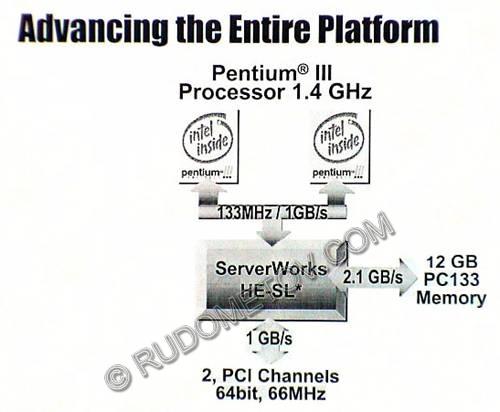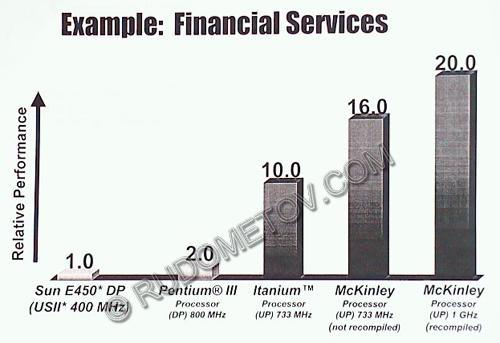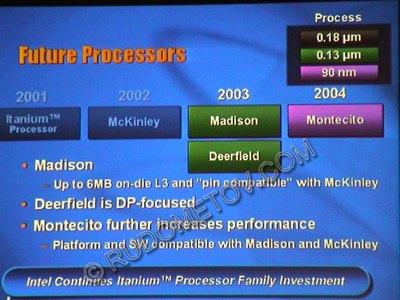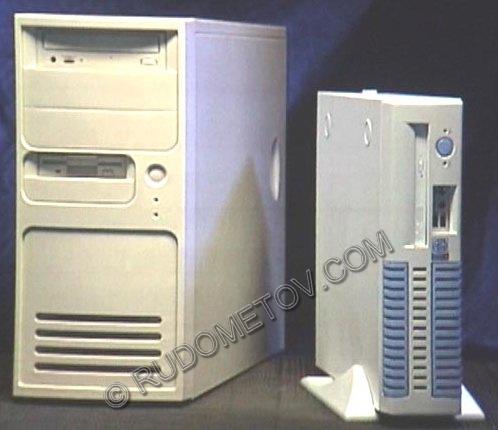It is published on site Fcenter
IDF Spring 2002
(Continuation)
Evgenie Rudometov.
authors@rudometov.com
![]() It is necessary to mark, that processors of microarchitecture of Intel XScale cover a wide band of possible applications: from smart phones to server arrangements. It was in detail described by Thomas Frants (Thomas R. Franz, Vice President, General Manager, Network Processing Group, Intel Corporation) in the report.
It is necessary to mark, that processors of microarchitecture of Intel XScale cover a wide band of possible applications: from smart phones to server arrangements. It was in detail described by Thomas Frants (Thomas R. Franz, Vice President, General Manager, Network Processing Group, Intel Corporation) in the report.
![]()

![]() Network processors are calculated for usage in the most various environments: from the house and office to commutative centres of the companies-service providers.
Network processors are calculated for usage in the most various environments: from the house and office to commutative centres of the companies-service providers.
![]() Also Intel corporation has presented the integrated input-output processor working more than twice faster of the most efficient, offered Intels before clones.
Also Intel corporation has presented the integrated input-output processor working more than twice faster of the most efficient, offered Intels before clones.
![]() Into structure of the new set enter: the network processor of Intel IXP2800 for the main network applications (for example, for usage in superfast commutators/routers); the network processor of Intel IXP2400 for multifunctional commutators and the similar equipment installed in "reference points" of a network; and the network processor of Intel IXP425 for the equipment with which help in houses and offices hooking up on digital subscriber lines (DSL) is carried out, through cable modems to the Internet, and also to wireless local area networks.
Into structure of the new set enter: the network processor of Intel IXP2800 for the main network applications (for example, for usage in superfast commutators/routers); the network processor of Intel IXP2400 for multifunctional commutators and the similar equipment installed in "reference points" of a network; and the network processor of Intel IXP425 for the equipment with which help in houses and offices hooking up on digital subscriber lines (DSL) is carried out, through cable modems to the Internet, and also to wireless local area networks.
![]() Completely programmed network processors IXP2800 and IXP2400 work on speeds 10 Gbit/with (OC-192) and 2,5 Gbit/with (OC-48), accordingly. In these products technological reaching under name Hyper Task Chaining is realised, allowing these processors simultaneously to fulfil set of operations that provides maximum productivity of a network and constant sufficiency of its capacity for simultaneous usage of a considerable quantity of complex services.
Completely programmed network processors IXP2800 and IXP2400 work on speeds 10 Gbit/with (OC-192) and 2,5 Gbit/with (OC-48), accordingly. In these products technological reaching under name Hyper Task Chaining is realised, allowing these processors simultaneously to fulfil set of operations that provides maximum productivity of a network and constant sufficiency of its capacity for simultaneous usage of a considerable quantity of complex services.
![]() Network processor IXP425 considerably simplifies engineering of computer systems: in it support vocal and video applications, and also applications for operation with data in a wide spectrum of the transport environments, including standard versions DSL, cable hooking up to the Internet, HDLC, wireless interconnections of standard IEEE 802.11x and networks of standard Ethernet is realised.
Network processor IXP425 considerably simplifies engineering of computer systems: in it support vocal and video applications, and also applications for operation with data in a wide spectrum of the transport environments, including standard versions DSL, cable hooking up to the Internet, HDLC, wireless interconnections of standard IEEE 802.11x and networks of standard Ethernet is realised.
![]() The input-output processor of Intel IOP321 working on frequency of 400 or 600 MHz, is optimised under high-powered, economically effective storage devices. Reduced energopotreblenie saves of necessity to instal the heat-removing heat sink, and the construction on the basis of one chip will allow designers to save a place on system boards.
The input-output processor of Intel IOP321 working on frequency of 400 or 600 MHz, is optimised under high-powered, economically effective storage devices. Reduced energopotreblenie saves of necessity to instal the heat-removing heat sink, and the construction on the basis of one chip will allow designers to save a place on system boards.
![]() The input-output processor of Intel IOP321 supports bus PCI-X allowing servers and storage arrangements to handle data in system on more high speeds. Besides, PCI-X helps to compensate negative influence of "bottlenecks" of a network, usage of this bus gives the common improvement of metrics of system operation of input-output of high-powered systems, for example, created on the basis of chip set Е7500 and processors of Intel Xeon. Also matching of structure, key parametres and productivity of these systems, and also the products which basis is made by 64-bit processors, with less efficient predecessors has been, of course, visually presented.
The input-output processor of Intel IOP321 supports bus PCI-X allowing servers and storage arrangements to handle data in system on more high speeds. Besides, PCI-X helps to compensate negative influence of "bottlenecks" of a network, usage of this bus gives the common improvement of metrics of system operation of input-output of high-powered systems, for example, created on the basis of chip set Е7500 and processors of Intel Xeon. Also matching of structure, key parametres and productivity of these systems, and also the products which basis is made by 64-bit processors, with less efficient predecessors has been, of course, visually presented.
![]()

![]()

![]()

![]()

![]() It is possible to consider as natural continuation of the given systems the analysis of perspectives of development of high-powered processors.
It is possible to consider as natural continuation of the given systems the analysis of perspectives of development of high-powered processors.
![]()

![]() Have not been forgotten on IDF and others sektory the market.
Have not been forgotten on IDF and others sektory the market.
![]() Intel corporation has declared new processing techniques which will make dialogue of users with desktop computers, transportable PCs and wireless computing circuits is much easier, more convenient and more effective.
Intel corporation has declared new processing techniques which will make dialogue of users with desktop computers, transportable PCs and wireless computing circuits is much easier, more convenient and more effective.
![]() Among these processing techniques have been named the processor of Intel of a new generation for desktop systems and the new processor of Intel of Pentium preparing for release 4 – M for transportable computers. In addition to it processors for the wireless arrangements, calculated for operation in communication networks of generation 2,5 and 3 have been announced also.
Among these processing techniques have been named the processor of Intel of a new generation for desktop systems and the new processor of Intel of Pentium preparing for release 4 – M for transportable computers. In addition to it processors for the wireless arrangements, calculated for operation in communication networks of generation 2,5 and 3 have been announced also.
![]() Besides, representatives of a manual of corporation, appearing at a spring forum of Intel for implementators of 2002, have marked successes of some branch initiatives, including: 3GIO – processing techniques of high-speed data transfer between arrangements in the computer. Its implantation in the architecture of computers will allow to increase sharply informational streams between subsystems.
Besides, representatives of a manual of corporation, appearing at a spring forum of Intel for implementators of 2002, have marked successes of some branch initiatives, including: 3GIO – processing techniques of high-speed data transfer between arrangements in the computer. Its implantation in the architecture of computers will allow to increase sharply informational streams between subsystems.
![]()

![]() Accessing to implementators, Lui Burns (Louis Burns, Vice President, Intel Architecture Group, Vice President, General Manager, Desktop Platforms Group, Intel Corporation), the vice-president and the general director of group Desktop Platforms Group, has told about schedules of corporation concerning the new processor of Intel preparing for release for desktop PCs which carries now code name Prescott. This processor planned to release in 2003, is the representative of following generation of processors of Intel on the basis of microarchitecture of Intel NetBurst. In processor Prescott, besides other, the processing technique of multithreaded processing of signals Hyper-Threading (this developed Intel the processing technique allows the operating system to work with one processor how if them was two, that considerably raises the common productivity of all platform) will be realised. Besides, Burns has shown the processor of Intel of Pentium 4, working on various clock rates in a band to 4 GHz. However, while the given variant of the processor worked not with traditional, and with special resources of cooling.
Accessing to implementators, Lui Burns (Louis Burns, Vice President, Intel Architecture Group, Vice President, General Manager, Desktop Platforms Group, Intel Corporation), the vice-president and the general director of group Desktop Platforms Group, has told about schedules of corporation concerning the new processor of Intel preparing for release for desktop PCs which carries now code name Prescott. This processor planned to release in 2003, is the representative of following generation of processors of Intel on the basis of microarchitecture of Intel NetBurst. In processor Prescott, besides other, the processing technique of multithreaded processing of signals Hyper-Threading (this developed Intel the processing technique allows the operating system to work with one processor how if them was two, that considerably raises the common productivity of all platform) will be realised. Besides, Burns has shown the processor of Intel of Pentium 4, working on various clock rates in a band to 4 GHz. However, while the given variant of the processor worked not with traditional, and with special resources of cooling.
![]()

![]() «The processor of Intel of Pentium 4 already became the main platform both for house, and for business users.», - Burns has told. «Within next year Intel corporation will carry out implantation of some innovative processing techniques which will accelerate compatibility of house digital devices and will expand possibilities of our desktop platforms, including at the expense of usage of new, more high-powered processors and form factors».
«The processor of Intel of Pentium 4 already became the main platform both for house, and for business users.», - Burns has told. «Within next year Intel corporation will carry out implantation of some innovative processing techniques which will accelerate compatibility of house digital devices and will expand possibilities of our desktop platforms, including at the expense of usage of new, more high-powered processors and form factors».
![]()

![]() Rise of productivity of processors demands also adequate resources of maintenance of the optimal temperature mode more effective fans and heat sinks become which basis in the near future.
Rise of productivity of processors demands also adequate resources of maintenance of the optimal temperature mode more effective fans and heat sinks become which basis in the near future.
![]()

![]() Burns announced also the new initiative routed on standardization of form factors of systems on the basis of structural components of 3GIO architecture. Intel corporation plans to realise support of this architecture in a wide spectrum of production. Release of the first appropriate chip is planned for second half of 2003.
Burns announced also the new initiative routed on standardization of form factors of systems on the basis of structural components of 3GIO architecture. Intel corporation plans to realise support of this architecture in a wide spectrum of production. Release of the first appropriate chip is planned for second half of 2003.
![]()

![]() Anand Chandraseher (Anand Chandrasekher, Vice President, General Manager, Mobile Platforms Group, Intel Corporation), the vice-president and the general manager of division of Intel Mobile Platforms Group has told about technical advantages of the processor of Intel of Pentium preparing for release 4 – M for transportable computers and has shown it in operation, having shown video data playback (1080i) with quality of a digital cable television at program decoding on a usual notebook.
Anand Chandraseher (Anand Chandrasekher, Vice President, General Manager, Mobile Platforms Group, Intel Corporation), the vice-president and the general manager of division of Intel Mobile Platforms Group has told about technical advantages of the processor of Intel of Pentium preparing for release 4 – M for transportable computers and has shown it in operation, having shown video data playback (1080i) with quality of a digital cable television at program decoding on a usual notebook.
To pass to razrelu Processors
 English
English Russian
Russian German
German